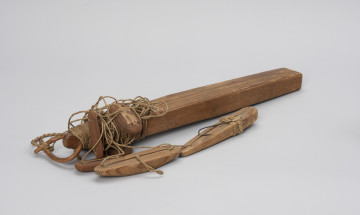
Floating fishing rod
1920 — 1950
National Museum in Szczecin
Part of the collection: Traditional fishing
Winter fishing required the use of ice crampons, which were fastened to footwear using leather straps or hemp belts. They prevented slipping and falling, especially when handling seine nets, as fishermen pulled the nets from an ice hole and needed a firm grip on the ice. Crampons were known in Europe as early as the Bronze Age. In medieval Poland, three-pronged claw-like or four-pronged forms were common, as evidenced by finds from 12th- and 13th-century archaeological layers uncovered in Gdańsk and Szczecin. They were also used by rafters on rafts, less commonly by hunters, and occasionally by farmers cutting reeds on lakes. Even after World War II, they were widely used by fishermen. They were called żabki (little frogs), chrapcie (spiked straps), ostrogi (spurs), and in Kashubia, they were also referred to as krace and bierdziadla. To this day, they are still used in winter mountain tourism and climbing, helping maintain stability on snow-covered and icy surfaces. The collection of the Pomeranian Ethnography Department contains 17 pairs of crampons. The four-pronged pair presented here, with a rectangular base that attached to the shoe sole, comes from the Szczecin Lagoon. It was purchased for the museum's collection in 1949. Małgorzata Kłosińska-Grzechowiak
Other names
żabki (little frogs), raczki (small crampons), chrapcie (spiked straps), krace (Kashubian), ostrogi (spurs), bierdzadla (Kashubian)
Author / creator
Object type
furnishings and equipment
Technique
blacksmith techniques, forging, bending, obróbka mechaniczna, tanning
Material
iron, sznur, leather, rzemień skórzany, bawełniana tkanina;
Origin / acquisition method
purchase
Creation time / dating
Creation / finding place
Owner
The National Museum in Szczecin
Identification number
Location / status

1920 — 1950
National Museum in Szczecin

1901 — 1950
National Museum in Szczecin

1901 — 1950
National Museum in Szczecin
DISCOVER this TOPIC
Museum of King Jan III's Palace at Wilanów
DISCOVER this PATH
Educational path